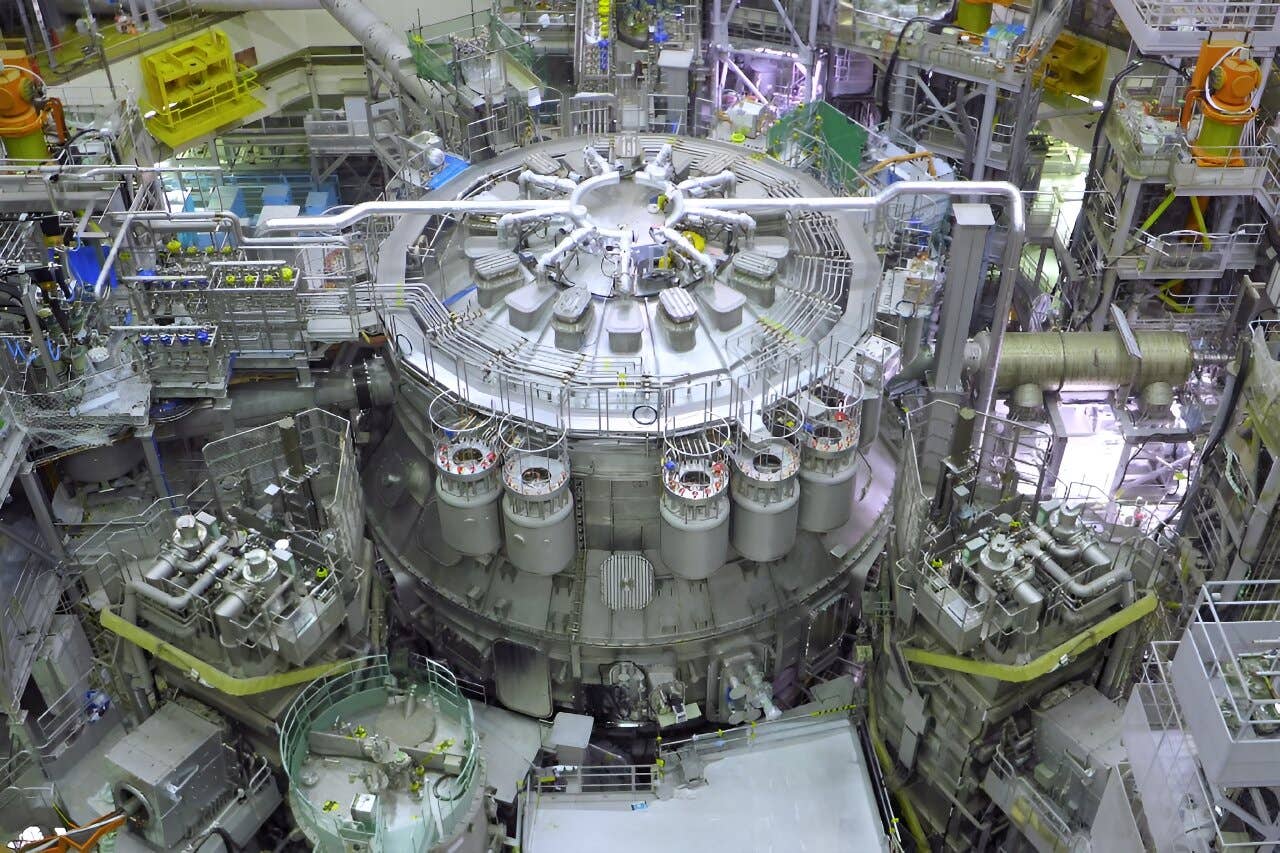World’s largest nuclear fusion reactor promises to reshape global energy production
In a historic moment that promises to reshape the future of energy, Japan launched the world’s largest experimental nuclear fusion reactor.

In a historic moment that promises to reshape the future of energy production, Japan inaugurated the world's largest experimental nuclear fusion reactor. (CREDIT: ITER)
In a historic moment that promises to reshape the future of energy production, Japan inaugurated the world's largest experimental nuclear fusion reactor. This monumental undertaking, known as the JT-60SA reactor, marks a significant stride in the pursuit of harnessing the power of nuclear fusion, a technology still in its infancy but hailed by many as the answer to humanity's future energy needs.
Fusion, a groundbreaking process that distinguishes itself from the prevailing nuclear fission technique utilized in existing nuclear power plants, involves the fusion of two atomic nuclei, as opposed to the splitting of one.
The primary objective behind the JT-60SA reactor is to scrutinize the viability of fusion as a safe, large-scale, and carbon-free source of net energy. The ultimate goal is to generate more energy from fusion than is consumed in the process of producing it.
Pictured, the JT-60SA, the world's biggest nuclear fusion reactor constructed to date, prior to its inauguration in the city of Naka, Ibaraki prefecture, Japan. (CREDIT: National Institutes for Quantum)
Situated in a hangar in Naka, just north of Tokyo, this colossal six-story-high machine features a donut-shaped "tokamak" vessel designed to contain swirling plasma heated to an astonishing 200 million degrees Celsius (360 million degrees Fahrenheit).
This ambitious project is a collaborative effort between the European Union and Japan, serving as a precursor to the International Thermonuclear Experimental Reactor (ITER) in France, which is currently under construction.
The core aspiration shared by both the JT-60SA and ITER projects is to coax hydrogen nuclei to fuse into a heavier element, helium, liberating energy in the form of light and heat.
Related Stories
This process seeks to replicate the natural phenomenon occurring inside the sun, where fusion reactions power our solar system. Achieving the elusive "net energy" in nuclear fusion has been the holy grail of researchers in the field.
Reflecting on this significant achievement, Sam Davis, the deputy project leader for the JT-60SA, expressed his optimism, stating that the device will "bring us closer to fusion energy." He further emphasized the collaborative nature of the endeavor, involving more than 500 scientists and engineers and over 70 companies across Europe and Japan.
EU energy commissioner Kadri Simson praised the JT-60SA, describing it as "the most advanced tokamak in the world" and characterizing the commencement of operations as "a milestone for fusion history." Simson also highlighted fusion's potential to become a pivotal component of the global energy mix in the latter half of this century.
Graphic comparing nuclear fusion vs fission, two physical processes that produce massive amounts of energy and yield millions of times more energy than other energy sources. (CREDIT: US Energy Dept, Duke Energy, EIA, AFP)
The achievement of "net energy gain" in fusion was notably demonstrated in December at the National Ignition Facility at Lawrence Livermore National Laboratory in the United States. This facility, home to the world's most extensive laser system, employs a distinct approach called inertial confinement fusion. In this method, high-energy lasers are simultaneously directed into a minuscule cylinder containing hydrogen.
The U.S. government hailed this accomplishment as a "landmark achievement" in the quest for an abundant, clean power source, and a means to reduce reliance on carbon-emitting fossil fuels, which contribute to climate change and geopolitical instability.
One of the paramount advantages of fusion over fission is its inherent safety. Fusion carries no risk of catastrophic nuclear accidents like those witnessed in Fukushima, Japan, in 2011. Furthermore, fusion power plants produce substantially less radioactive waste compared to their fission-based counterparts, making them a more sustainable and environmentally friendly energy solution.
As the world grapples with the pressing need to transition to cleaner and more sustainable energy sources, the successful operation of the JT-60SA reactor in Japan, along with advancements in fusion research globally, presents a glimmer of hope. The potential for fusion to revolutionize our energy landscape cannot be overstated.
Fusion's unique promise lies in its ability to provide virtually limitless energy, while simultaneously minimizing the environmental and safety concerns associated with nuclear fission.
If fusion can indeed achieve net energy production on a large scale, it could serve as a crucial pillar of a future characterized by clean, reliable, and sustainable energy generation.
However, it is essential to acknowledge the challenges and hurdles that remain on the path to practical fusion energy. The International Thermonuclear Experimental Reactor (ITER), while ambitious and promising, faces budgetary issues, delays, and significant technical challenges. These obstacles underscore the complexity of achieving sustained nuclear fusion.
Despite these challenges, the inauguration of the JT-60SA reactor in Japan serves as a potent reminder of the determination and collaboration of scientists, engineers, and nations worldwide in the pursuit of a clean energy future.
The spherical tokamak (called the ST40) uses a powerful magnetic field to confine hydrogen isotopes into a spherical shape, similar to a cored apple, as they are heated by microwaves into a plasma to produce fusion - and clean energy. (CREDIT: Daily Mail)
Fusion's potential to revolutionize the global energy landscape is a beacon of hope in our quest to address climate change, reduce our dependence on fossil fuels, and ensure a sustainable future for generations to come.
As we continue to explore this groundbreaking technology, the prospects of achieving net energy production offer hope for a cleaner, more sustainable, and secure energy future. Fusion's potential to revolutionize the world's energy landscape cannot be underestimated, and the collaborative efforts of scientists and nations in this endeavor demonstrate the commitment to a better future for all.
Here is a table that summarizes the key differences between nuclear fusion and conventional nuclear reactors:
Potential benefits of nuclear fusion:
Nearly limitless fuel supply: The fuel for nuclear fusion is abundant and can be easily extracted from seawater.
Low-carbon energy source: Nuclear fusion does not produce any greenhouse gases.
Inherently safe: The fusion reaction will automatically stop if the reactor is damaged.
Low-level radioactive waste: Nuclear fusion produces only helium, a non-radioactive gas.
Potential challenges of nuclear fusion:
Very difficult to achieve and maintain the high temperatures and pressures required for fusion.
Materials development: The materials used in a fusion reactor must be able to withstand extreme temperatures and pressures.
Cost: Nuclear fusion reactors are still in the early stages of development, and they are likely to be very expensive to build.
For more science news stories check out our New Innovations section at The Brighter Side of News.
Note: Materials provided above by The Brighter Side of News. Content may be edited for style and length.
Like these kind of feel good stories? Get the Brighter Side of News' newsletter.
Joseph Shavit
Head Science News Writer | Communicating Innovation & Discovery
Based in Los Angeles, Joseph Shavit is an accomplished science journalist, head science news writer and co-founder at The Brighter Side of News, where he translates cutting-edge discoveries into compelling stories for a broad audience. With a strong background spanning science, business, product management, media leadership, and entrepreneurship, Joseph brings a unique perspective to science communication. His expertise allows him to uncover the intersection of technological advancements and market potential, shedding light on how groundbreaking research evolves into transformative products and industries.



